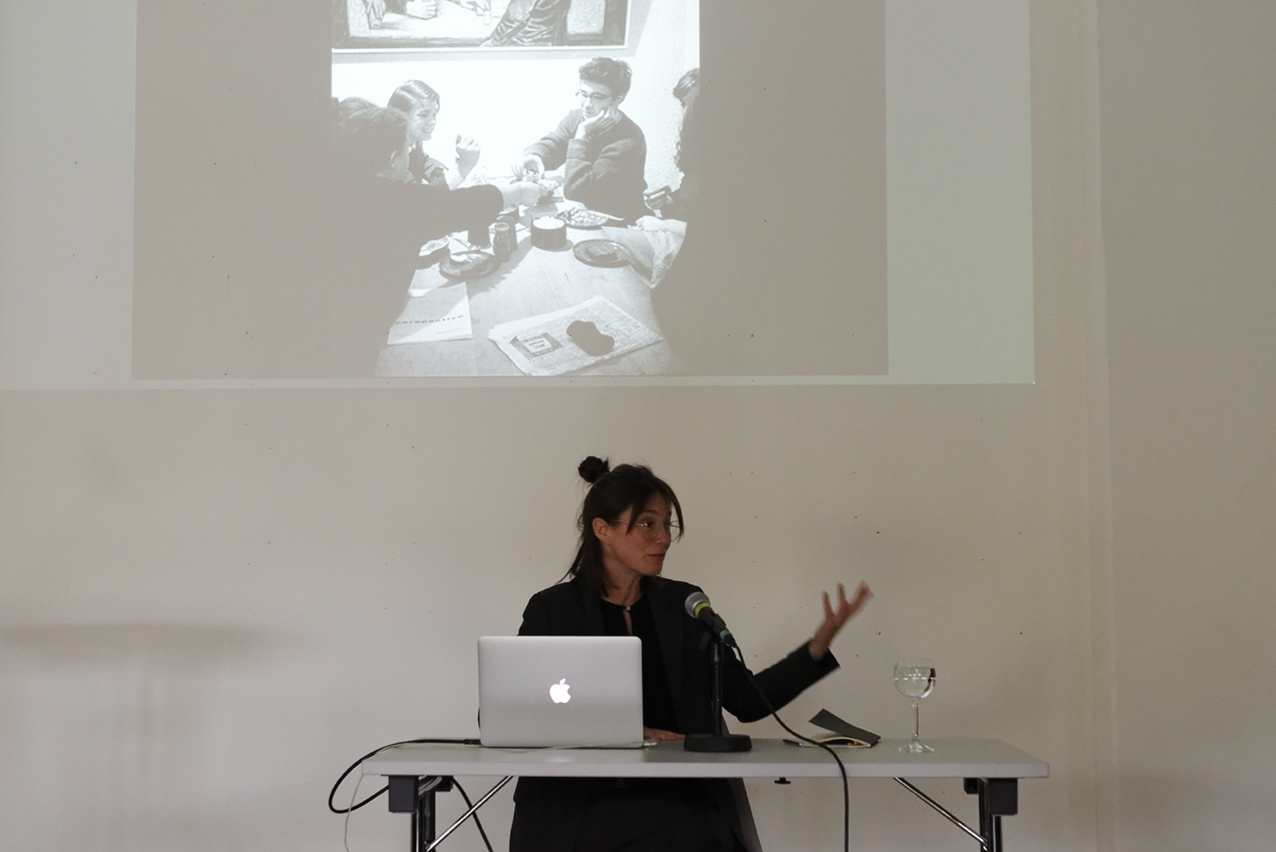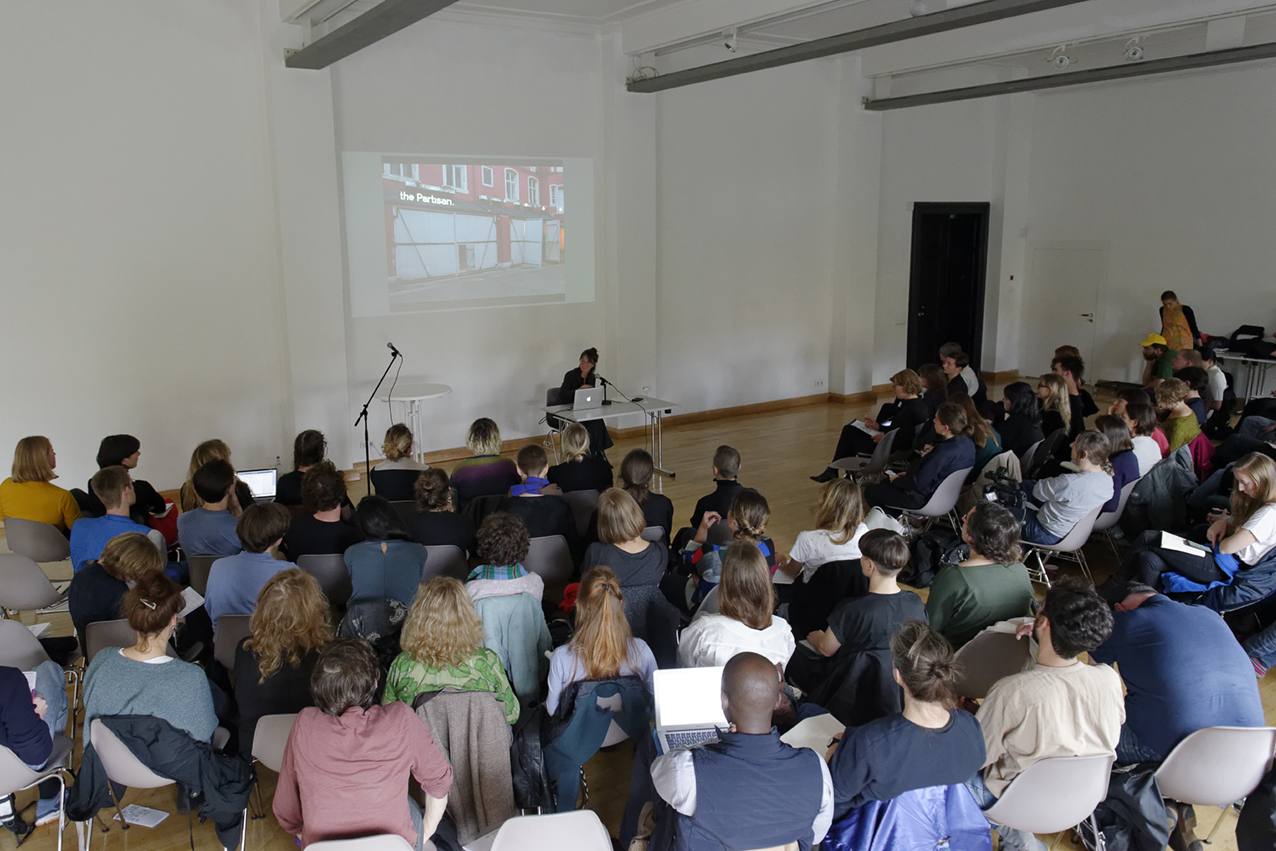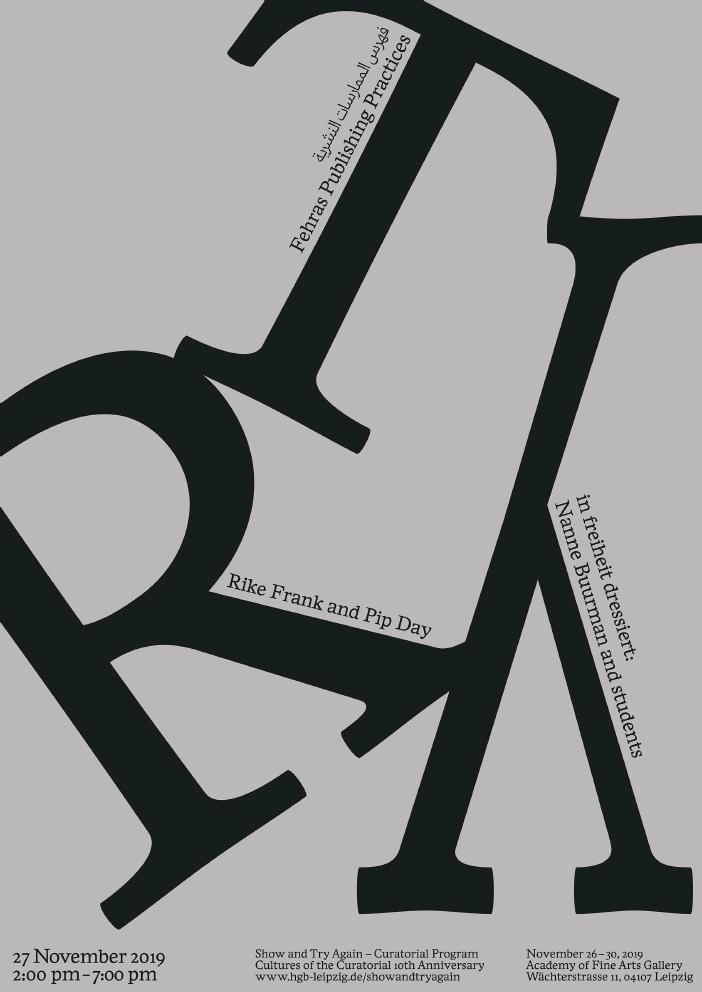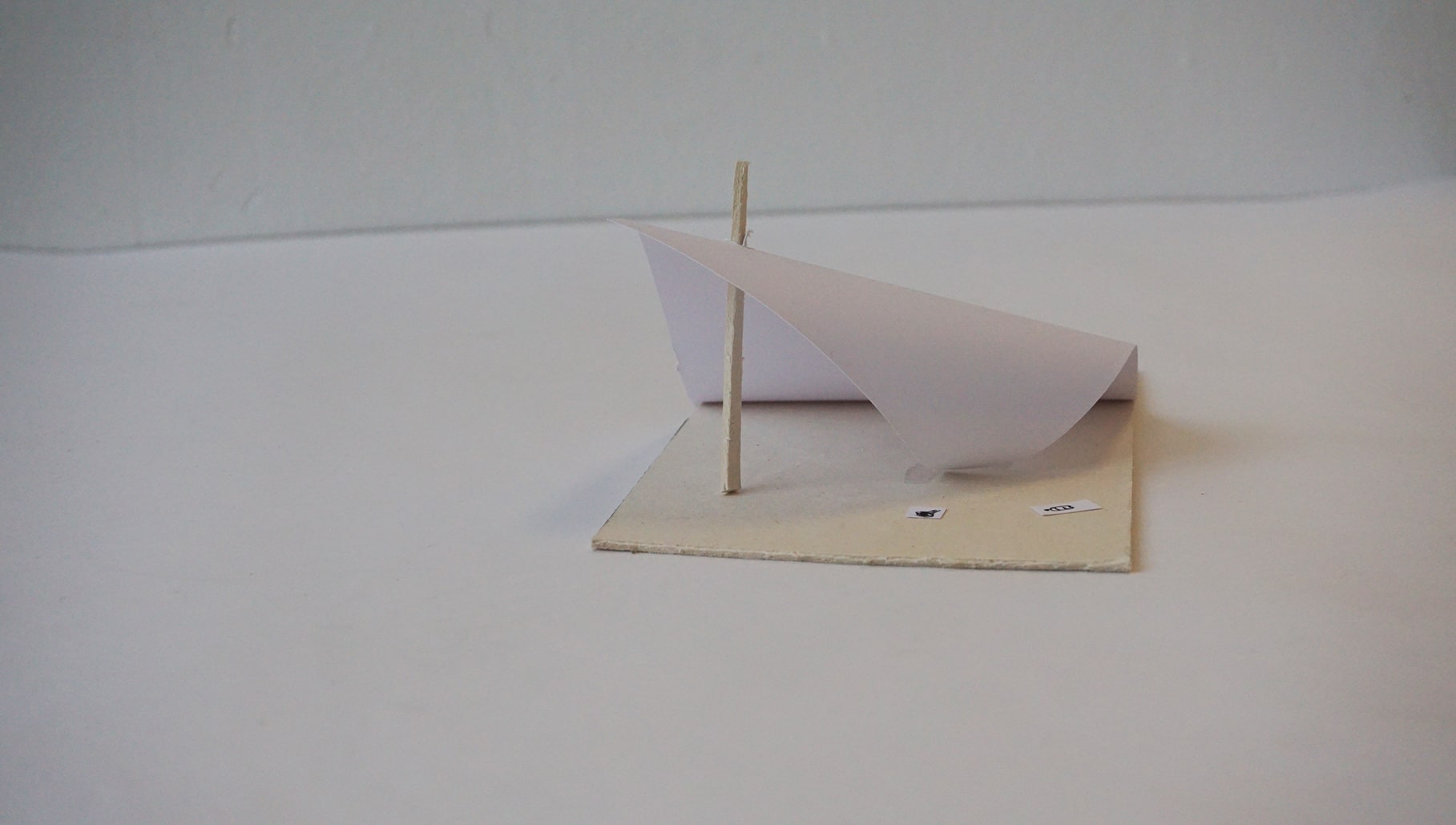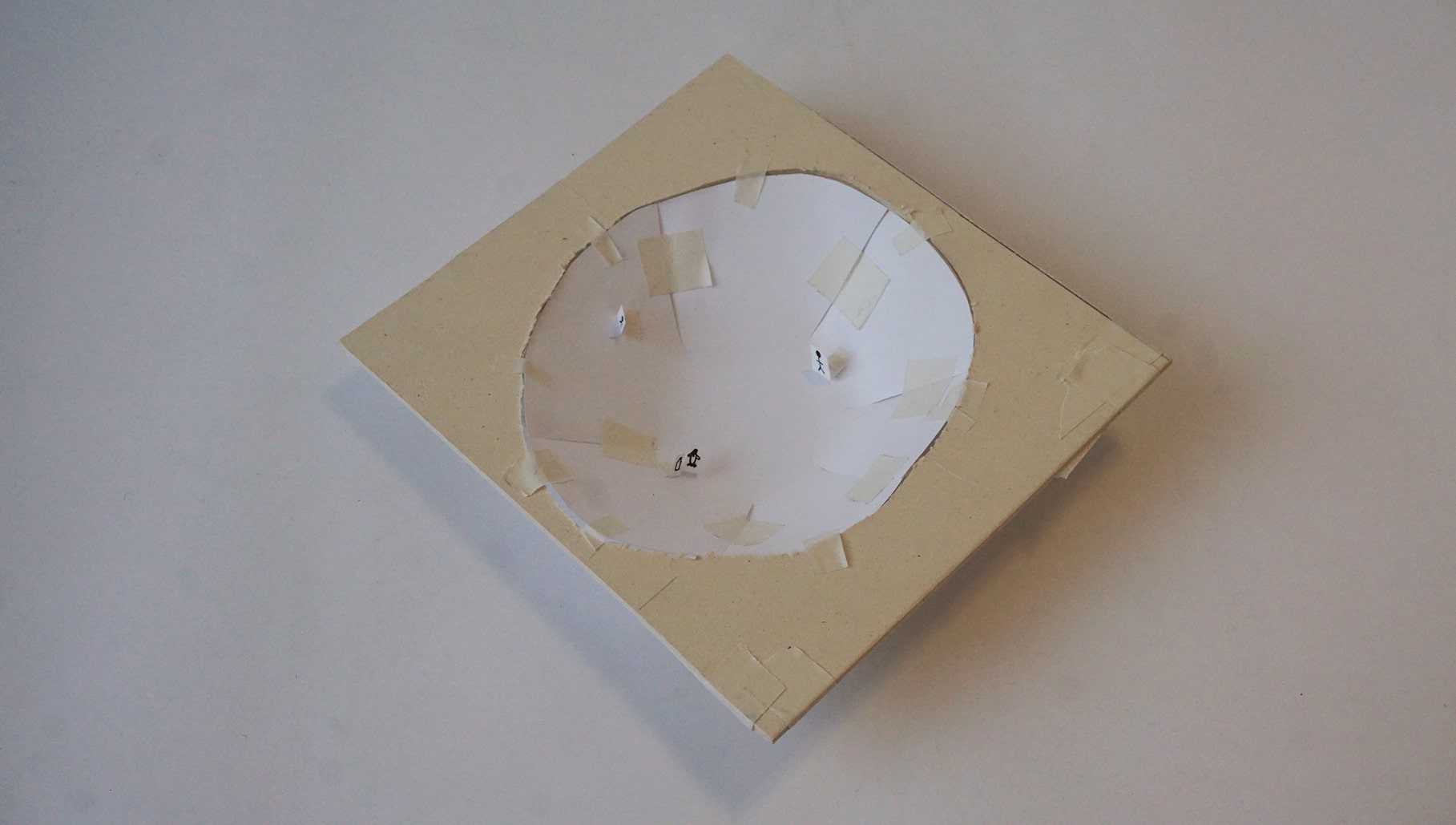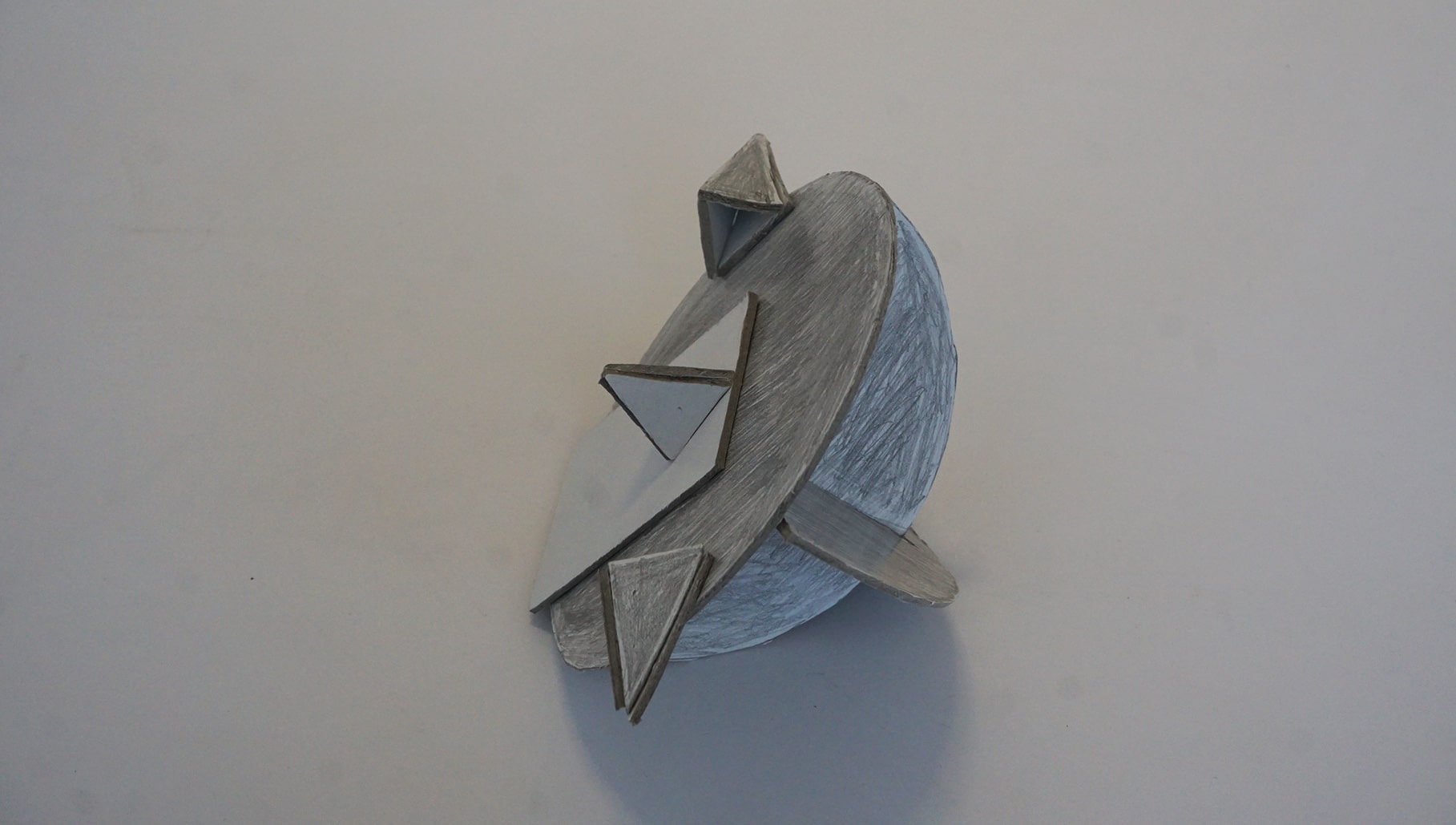nanne buurman & students
Performance with
Nanne Buurman, Johanna Brummack, Thea Drechsler, Anna Fischer de Saa, Mirjam Habtemichael, Luna Hirt, Pia Jansen, Alina Pia Preuß, Friederike Suhr, and others
in freiheit dressiert / being natural is simply a pose
[read more ⤵]
In 1919, the same year that the Bauhaus was founded, a group of women started the Loheland school for Physical Education, Agriculture and Craft to provide other women with a holistic education as gymnastics teachers. Dubbed at the time as the “Amazons’ State in the Rhön”, their program to liberate the body from civilizational corsets by recovering its “natural range of motion” later tempted Ernst Bloch to describe these life reform settlers as a “purification movement” whose unrestricted but nevertheless artful demeanor appeared like being “dressed in freedom.” Now, one hundred years later, participants of Nanne Buurman’s curatorial research seminar at Kunsthochschule Kassel spent the summer of 2019 engaging with the parallels between historical life reform practices and today’s slow-and-conscious living trends, such as yoga, detox and decluttering. From November 18th through the 22nd, they set up the exhibition “in freiheit dressiert // being natural is simply a pose” in Kassel as a laboratory to jointly investigate the political ambivalences of back-to-nature movements then an now. Notions of immediacy, transparency and purity were critically examined by curatorial means in order to better understand the deployment of “nature” and “naturalness” in the context of neoliberal greenwashing and the (new) right.For Show and Try Again, the group (Buurman together with Johanna Brummack, Thea Drechsler, Anna Fischer de Saa, Mirjam Habtemichael, Luna Hirt, Pia Jansen, Alina Pia Preuß, Friederike Suhr and others) will experiment with a repertoire of Lohelandian body practices through the lens of voguing to reflect on the biopolitical implications of historical modes of subjectivation and their contemporary reenactments. Nanne Buurman, Johanna Brummack, Thea Drechsler, Anna Fischer de Saa, Mirjam Habtemichael, Luna Hirt, Pia Jansen, Alina Pia Preuß, Friederike Suhr, and others
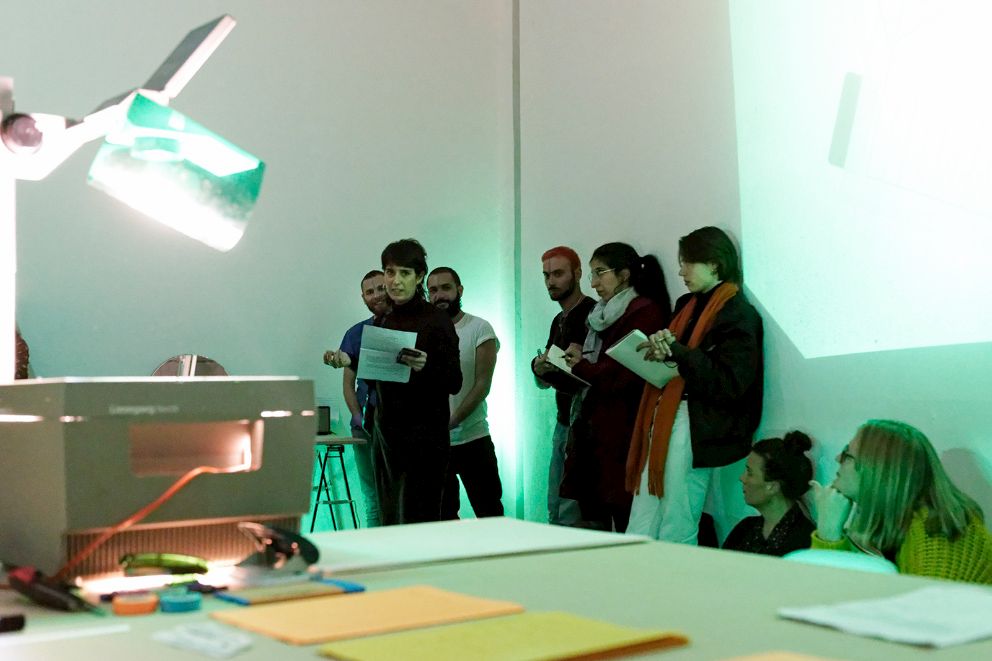
Fehras Publishing Practices: Missing Languages, Dominating Terms | Performance, 27 November 2019, HGB Gallery.Photo: Sandra Schubert
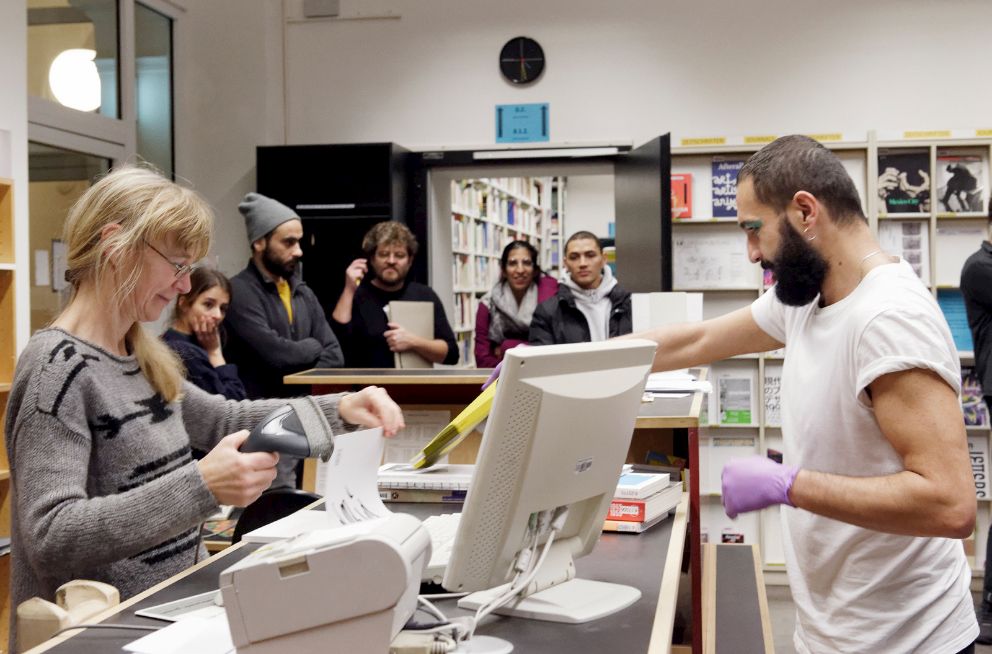
Fehras Publishing Practices: Missing Languages, Dominating Terms | Performance, 27 November 2019, HGB Gallery.Photo: Sandra Schubert
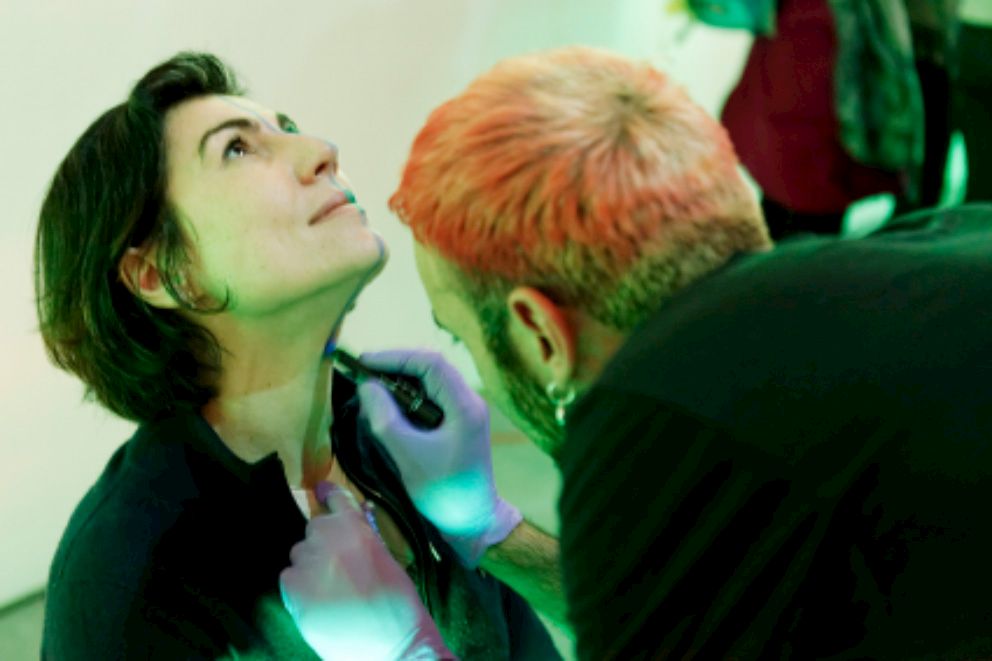
Fehras Publishing Practices: Missing Languages, Dominating Terms | Performance, 27 November 2019, HGB Gallery.Photo: Sandra Schubert
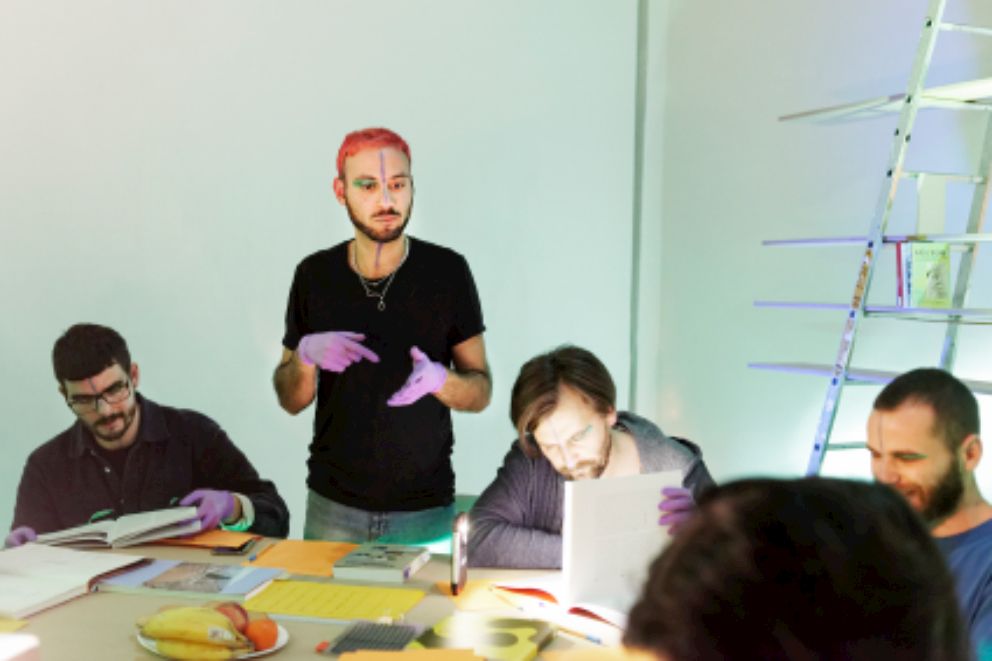
Fehras Publishing Practices: Missing Languages, Dominating Terms | Performance, 27 November 2019, HGB Gallery.Photo: Sandra Schubert
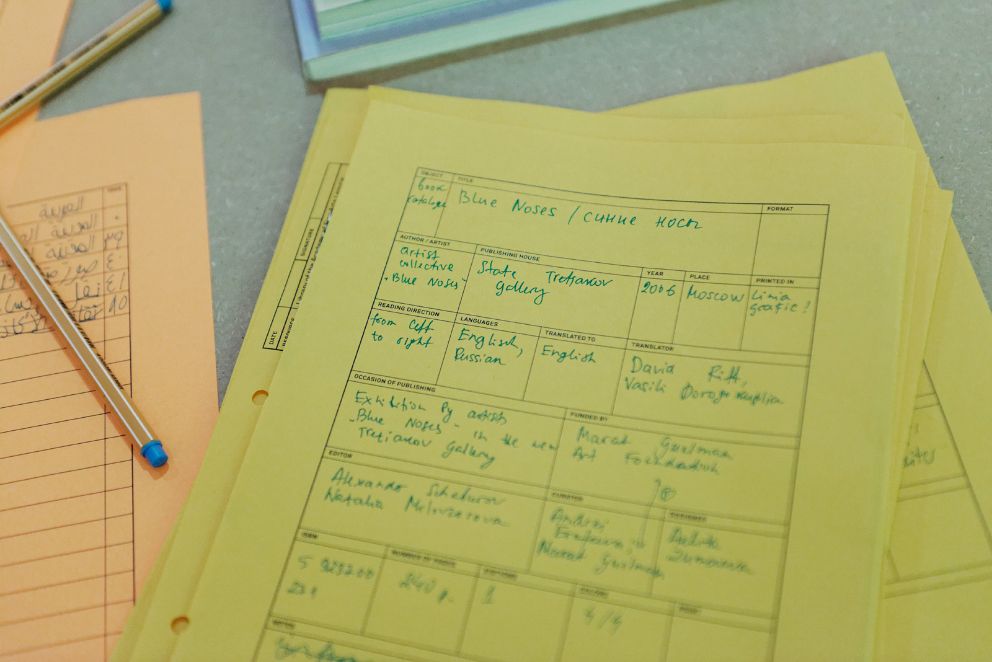
Fehras Publishing Practices: Missing Languages, Dominating Terms | Performance, 27 November 2019, HGB Gallery.Photo: Sandra Schubert
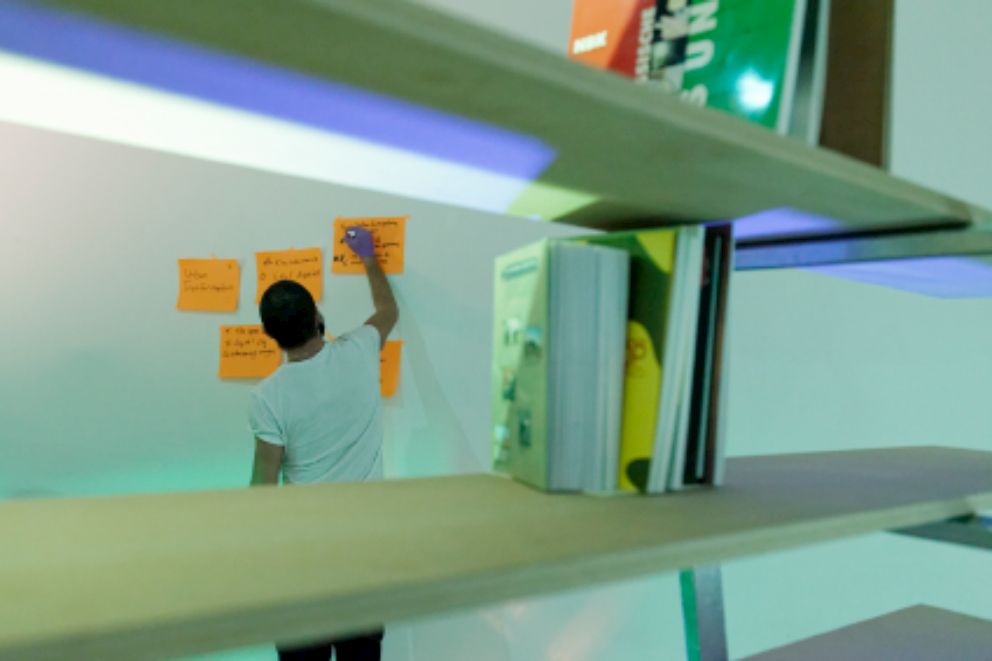
Fehras Publishing Practices: Missing Languages, Dominating Terms | Performance, 27 November 2019, HGB Gallery.Photo: Sandra Schubert
curatorial research
chris paxton
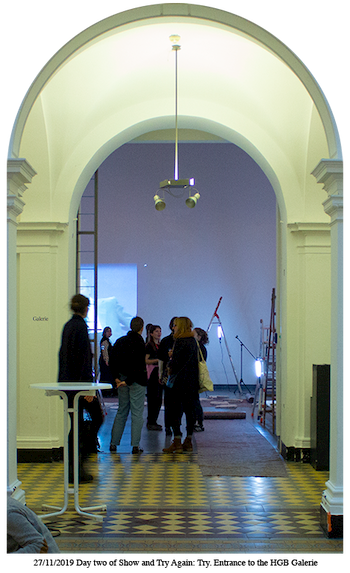
asya yaghmurian
Show and try again?
Showing as non-action, as a state of being.
Treating show as a process that constantly evolves as on open space that welcomes new participants and ideas.
Accepting the neutral space and not treating the activities and knowledge as goods.
There is no ‘us’ and there is no ‘them’, there is no ‘inside’ and there is no ‘outside’.
We should talk more about art.
Trusting the process of the show, thus trusting the pause, the gap, the anarchic dimension.
Considering to not show, not try or never again.
Freeing the show, emancipating it from the structures.
Thinking about what to offer to the show and what to offer to try.
Questioning the show and questioning what do you want to show.
Finding the right addressee for the question.
Showing the try is already a show.
Showing the things that are not supposed to be shown.
Trying to show on behalf of others, the ones who don’t have the tools to assembly.
Trying to avoid the clashes of the show.
Being careful not to be stuck in the loopholes of the show.
Not bringing boredom to try again or to show.
Being careful not to cross the line between the show and the showoff.
Showing the assembly, not assembling the show.
Remembering and caring about the spectator who finally shapes the show.
Walking with the spectator through the show.
Imagining the show, as seen from non-show, assembly or try!
jana dohmann
QUESTIONING THE AFTER-SHOW
is the result of a field research—trying to capture the voices of the audience in the form of questions.
It created an archive of collected questions, that have grown out of the participation in the 5 days of Show and Try Again.
Following the approach of generating a living archive that stimulates new reflections and serves as a starting point for new discussions, this encyclopedia was translated into a game—that brings the manifold thoughts of visitors, participants, artists and initiators into motion and contact.
This format uses the active, discursive qualities inherent in the nature of the questions and tries to catalogue some of the experiences of the various participants in the program.
You are cordially invited to download the game and question the follow-up of the program-week in a playful way.
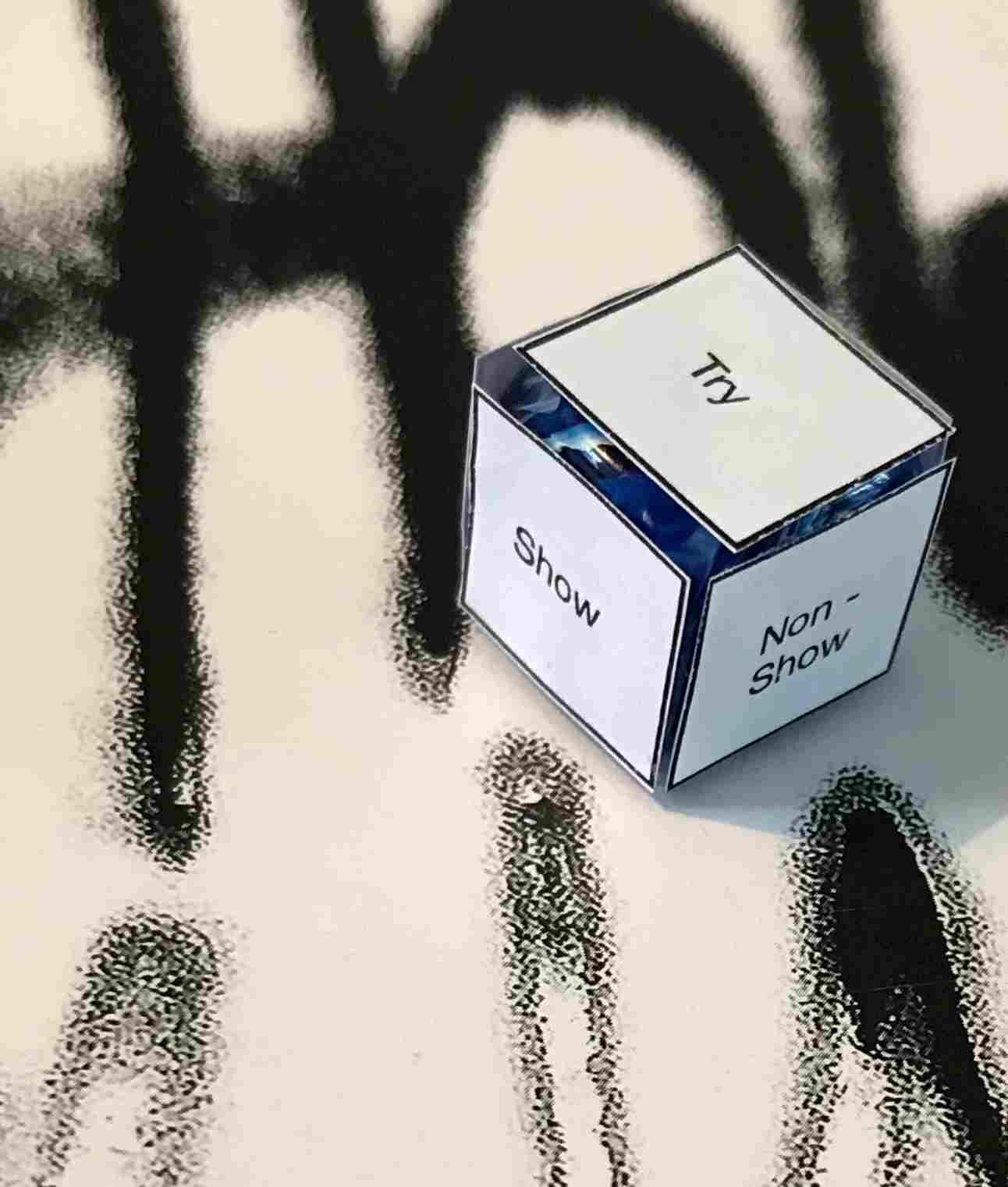
How do (these) processes of experimenting and re-arranging of given contexts perform as a laboratory?
How do they question and re-formulate the conditions on being on display?
What role does translation play when cultures are dominated or suppressed by language?
To what extent can translation be used as a tool of change within a global art language”?
Within dominant languages, can new concepts be formed and communication spaces opened?
And how can untranslatability be included in a process of cultural exchange?
Warum erzeugt es ‚discomfort‘ jmd. beim ausprobieren zuzuschauen?
Darf ausprobieren öffentlich sein? Muss ausprobieren öffentlich sein?
Wie lassen sich (zu) schnell etablierte Strukturen und Rollen in sozialen Gefügen dekonstruieren und neu definieren?
Was bringt dich dazu eine Frage zu stellen?
Who is in power?
Who’s research is it? And who is benefiting?
How is it possible to transfer knowledge?
How is it possible to talk back?
Does the talking back use the same terms?
What are the terms we rely on?
Is there a post-representational museum?
Do we need language to communicate?
How is it possible to invite someone to speak first?
How important are social contracts?
To whom ist the question addressed?
Erwartet man an einem Veranstaltungstag mit dem Titel Try eine professionelle, für die Öffentlichkeit relevante Performance?
How to create a space where to show and rehearse at the same time?
How is cultural appropriation exhibited?
How is it possible to invite the moment of trying (in a show, or an exhibition)?
What is critique?
How to situate critique?
Wie sehr beeinflusst die räumliche Gestaltung eines Veranstaltungsortes meine Zugänglichkeit als BesucherIn?
Was könnten Modelle der Raum- und Situationsgestaltung sein, die feste Hierarchien und Machtstrukturen innerhalb eines Settings vermeiden?
Inwieweit hat die Offenheit und ‚Unfertigkeit‘ eines Vortrags Einfluss darauf, wie ich mich adressiert fühle und mitdenke?
Ohne Lücken kein System — wie sehr bestimmen die Lücken in einem System darüber, ob ich Eingang darin finde?
How is it possible to invite and to use the potentials of failure?
How can we use the potentials of the unplanable in curatorial situations?
How can, in terms of the curatorial, the backstage of a topic, an exhibition, a context be shown and documented?
Do I take the mic?
Are there guidelines in artistic research?
How to implement the potential of waiting?
How can one ask back?
Is there an accessibility policy in the HGB?
Wie und woher kommt es, dass es oft nur die zwei klaren Positionen, Antworten & Fragen, innerhalb von Q&A- Situationen gibt und diese so unumstößlich etabliert sind?
Inwieweit ist die Schüchternheit in Q&A Situationen Fragen zu stellen, Spiegelung eines erlernten hierarchisch geprägten Musters aus dem Kontext von institutioneller Wissensvermittlung (Schule, Ausbildung, Studium)?
Wenn man sich seiner Meinung enthält, kann das als ein Moment des Pausierens verstanden werden? Oder ist es generell immer die Voraussetzung, eine Meinung oder eine Frage zu haben?
Warum wie ausstellen?
Welche Arten des Ausstellens bzw. Zeigens schließen wie, wen aus?
Can we extend methodologies of researching back to encompass wider questions of access and accessibility?
nushin atmaca
Translating Methodologies, Adopting Attitudes
When understood as a curatorial laboratory where new ways of practicing are thought of and enacted, trying seems to imply the translation of different approaches and methodologies into the field of the curatorial. However, they all seem to feed into an emphatic and sensitive attitude that does not only critically look at dominant, exclusive, racist, and colonial structures, but actively tries to deconstruct them.
The space designers of TRY during Show and Try Again aimed to translate the motto of the day into a space that invited the audience to participate and to try out things that they within the normally dominating structures of an exhibition, an installation, a talk, or a workshop would not do. Their concept succeeded—and one important aspect might have been that they also verbalized their thoughts for their audience, with a warm attitude that invited those present to use the space according to an idea that translated a motto into a spatial arrangement which thus was translated into words to make it even more accessible and meaningful.
Trying to create safe spaces by means of translation within the curatorial field does not only apply to spatial designs, but also to the deconstruction of dominating social and professional structures and the reinvention of protocols. Here, theories and methodologies of other academic and activist fields come into play: The adoption of, for example, decolonized and decolonizing methodologies into the field of the curatorial in itself is an act of translation. Which starting points do apply to the curatorial? Which hegemonies and structures dominate the field? Who are the marginalized, the invisibles, the unheard? And who are we—which position do we take, which position is ascribed to us as those working in the curatorial field? Whom do we present and whom to we claim to represent?
Once we find answers to these questions and succeed in translating critical methodology into the curatorial field and our own work, it will facilitate another act of translation, namely to put critical theory into practice: If we want to create a space for the marginalized, the invisible, the ones deliberately excluded in the global North which is dominated by white, male, heterosexual positions (to name but a few), the translation of a method that disrupts hegemonic structures in order to allow for perspectives hitherto unseen into our field might be the tool to make that happen.
Intrinsically linked to translating decolonized and decolonizing methods into the curatorial is the attitude that accompanies it. An attitude that is apt to dimension the own approach to what it is: a situational approach, rooted in time and place. At the same time, it often reflects the power structures we find in our surroundings. The dimensioning, but also the ‘abstraction’ of ourselves from the individual level to a structural one requires an act of translation as well: Translating our own presuppositions and assumptions, our social, cultural, educational ‘upbringing’ into words that illustrate our positionality as well as the positions we take. Where do we locate ourselves? Where are we actually located when we translate ourselves in terms of gender, ethnicity, sexuality etc. into the social and political structures we are living in?
Translation is a means to find answers to these questions—for ourselves and the audiences we are potentially addressing.
ariane graf

Through spaces, boundaries are consciously and unconsciously drawn between groups of people who have access to them and those who are denied it. Inaccessibility of rooms is based on the fact that access barriers are not consciously perceived and thus reproduced. Spaces are usually constructed in such a way that only a privileged group has access to them. Other groups of people are marginalized by obstacles to access them, such as physical, linguistic and cognitive barriers. Nevertheless, where access is possible, spaces are not safe spaces per se, as repressive mechanisms are at work in them.
TRY 1
Providing access and creating safe spaces for groups of people who have experienced oppression can in practice mean the temporary exclusion of those groups from whom oppression originates. For example, there are rooms / events where a save space for LTBQIA is explicitly created and where cis male are denied access. Similarly, the performative language laboratory of the artists' collective Fehras attempts to develop a glossary of global art terminology with selected native speakers. The project addresses groups of speakers who are underrepresented in the Western contemporary art world rather than those who already dominate the English-speaking scientific discourse.
Hegemonic structures loop in spaces whenever a privileged group is assumed to be the norm and all accesses and spatial structures are oriented towards it. The crux of exclusion and suppression mechanisms in spaces is their invisibility from the perspective of those who are "in" or from whom suppression emanates. To possess access means to possess privileges, which must be reflected upon, because the excluded groups are threatened by them. Without consciously locating one's own position and privileges in relation to space and accessibility, it is difficult to recognize the loops in which one is involved and which one is also reproducing, as it were.
TRY 2
In a lecture, the roles and positions of those who are present as well as the spatial structures can be made known and perceptible to everyone. An inherent normative set of rules reveals how behaviour has to be in relation to the room and those present. It is a continuous loop that creates comfort for those who can move freely in space, occupy it, have access to it and dominate it. A loop that regulates the behaviour of everyone in the room. To soften the hierarchical relationship between speakers and listeners can be achieved by passing the speaking sceptre. It allows the latter to speak and to initiate an equal dialogue between all those present. With speeches and questions from the audience, interaction can develop that has the potential to soften the existing hierarchies in the room.
In a curatorial practice in which spaces are created and thus access is also determined, it is necessary to become aware of hegemonic structures in spaces. Reflecting on one's own position plays an essential role here, in order to consistently use existing privileges for an open and safe design of spaces. It is important to critically observe who allows whom to appropriate a room. Whether, for example, a speech receptor circulates equally through the audience or whether only a certain group of people in the audience takes the floor and participates with long speeches. In order to really escape the loop and to soften hierarchies in the room, it is necessary to develop an awareness of who again has access (intellectually, linguistically) to be able to speak at all.
For a critical curatorial practice it is also necessary to be aware of the mechanism of closing and opening spaces. In this way, curated spaces can consciously address and invite groups of people who cannot be located in a majority society. This synthetic expropriation guarantees people from a social periphery an appropriation of spaces and is the possibility of stepping out of a loop. In this way, dominant, exclusive, racist, sexist and (neo-)colonial structures can not only be critically examined, but actively deconstructed / dissolved.
ewa meister
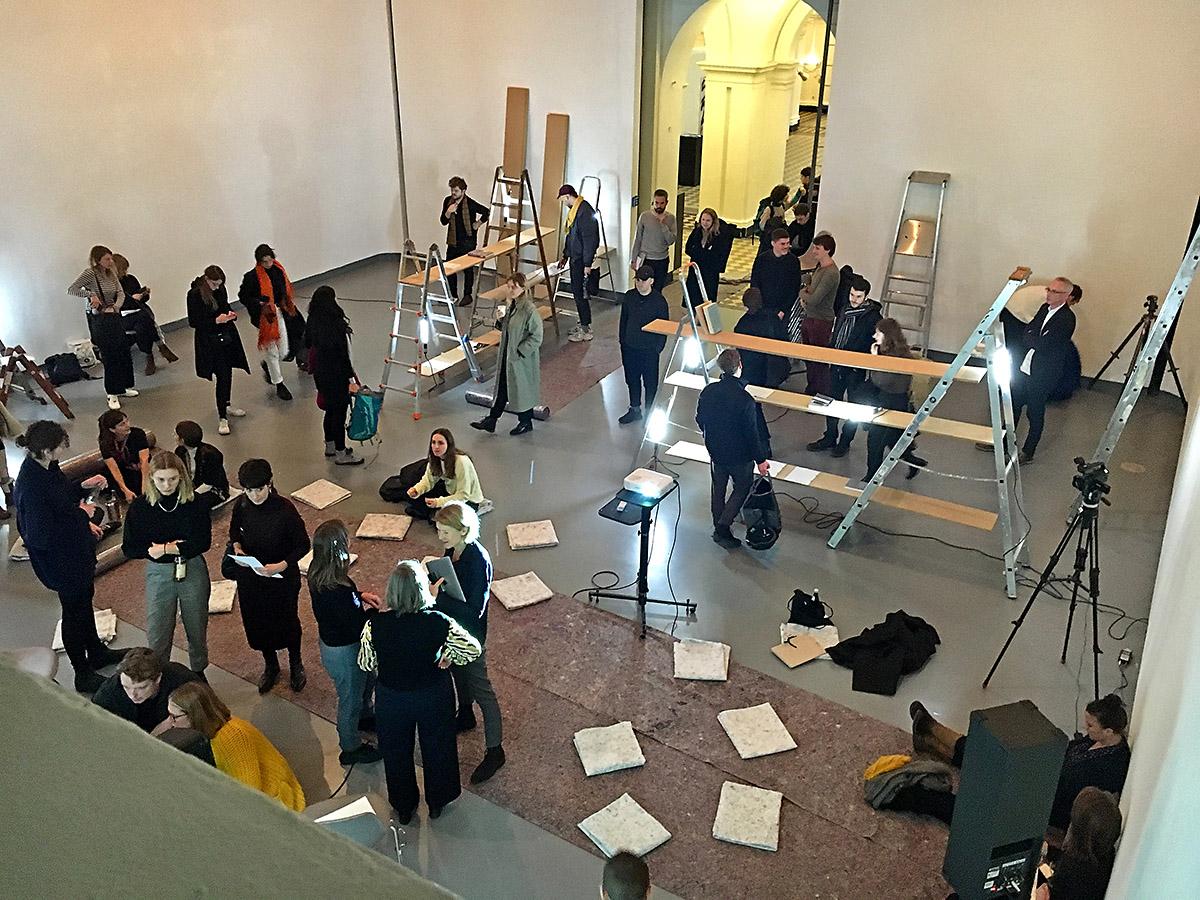
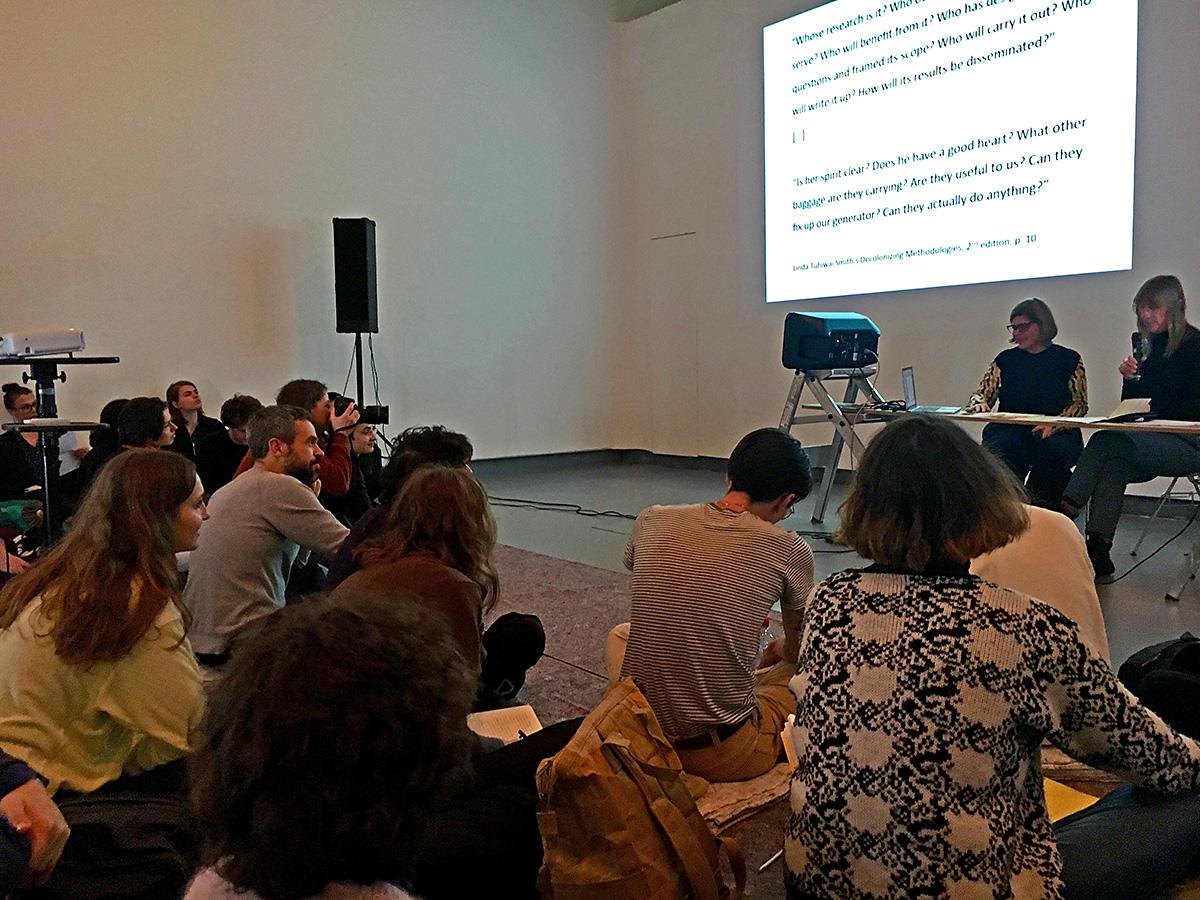
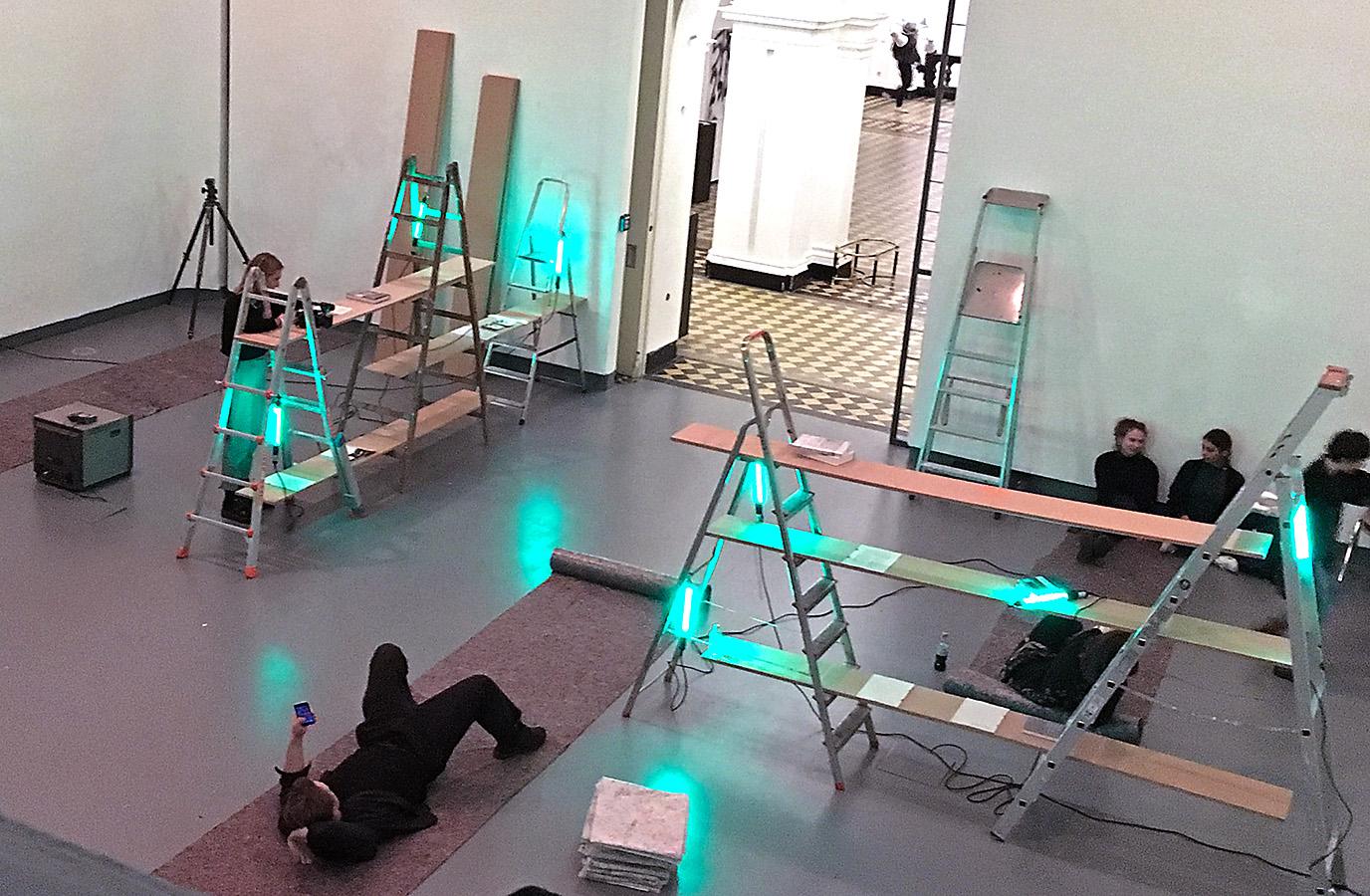
In fact, after a visit to a contemporary art exhibition, the only thing that truly remains in our memory is the organization of the spaces of that exhibition, especially if that organization is original and unusual.
The first thing one tries to do is to find out what the problem is, whether it's hierarchies or patriarchal systems that are still there. Point.
The next step would be to try to find out how to avoid that. That can also be very experimental, not only on paper, but spatial.
Spatial exclusion? Could obviously content exclusion be compensated through spatial inclusion?
Did you think about your own position and if it would have been better to stand or to have different chairs or to lay on the ground to be able to listen better to the events?
I would love to dare to sit on cushions or listen to an academic speech in sunbeds.
nadine vollmer
To listen with eyes closed while sitting on the floor with others, loosely arranged.
(A listening task by/with Jana).
Footsteps.
Quick strides through space.
Heels making loud clicking sounds are put on the ground in a hesitant way.
I hear the hesitation, the tiny lag of movement, the short halt of the foot in the air before it is put on the ground.
The heels make a loud clicking sound anyways.
No one here stands with her feet firmly grounded.
Soft soles.
Dok dok.
Again and again the walking, striding, running stops.
Paper rustles, is unfolded, then changing women’s voices read out a quote.
There is no necessary distinction between drag and subversion. Judith Butler.
Irgendwas von oben herab aufgelöst. Something dissolving from above. Ernst Bloch.
(My walking is my dancing, my talking is my dancing, Anne Teresa De Keersmaeker could say, but does not, not here.)
Dok dok.
Hedwig.
Luise.
Life reform.
Dance of the Avantgarde.
Confident voices, unconfident voices, solid intonation, non-solid intonation.
Dok dok.
There is a kind of hecticness in the room trying to be covered up with slowness.
Dok dok.
To open ones eyes and see:
It’s the loosened floor tile half left from me. Dok dok.
Again someone walks upon it.
Again some quote, again Butler or Bloch or Gabriele Brandstetter.
While the quote is being given all the performers remain in a pose.
Being Natural is Simply a Pose they call this evening.
But it’s not the poses that are natural.
What seems natural is rather the de-skilled, that which happens without being planned.
Dok dok.
Slowly groping one’s way forward into untrained terrain.
What does it mean to use body and voice in a specific way to appropriate a physical practice that is long gone.
A try, a trying out, an attempt, an approach, a testing.
Every approach is a test.
And a restaging as the videos on the wall prove.
Why this decision?
Shoe soles are a decision.
Every walk is a decision.
Every book that is taken from A to B and placed on one of those ladder shelves is a decision.
Every stride is a decision.
Every footstep is a decision.
(It gets difficult to neglect one's critical and deformed gaze the longer one’s eyes are open. Should I have closed them again?)
Many footsteps.
Many too many footsteps.
To fill the space with meaning.
Where there was _____ before.
Cut.
A space filled with ladders that balance shelves.
One could use them as a standing desk.
Or as a table.
But there are only two chairs for manypeople.
They are supposed to sit on the floor covered partially with some painter’s cloth.
“Is her spirit clear? Does he have a good heart? Can they fix up our generator?”
“Stefan!”
The tech person jumps up.
Two women at a ladder shelves that has the height of a desk and two chairs beside it.
Everyone else on the floor to their feet.
Two women that speak about (certainly hesitant, assuring one another, doubting):
Who speaks?
Who in the room does have the power to give the floor to someone, or to refuse.
“It’s about social contracts.”
Cold tingling feet from sitting too long in an uncomfortable way.
Who speaks in here?
How can we decolonize our methodologies?
How do you invite someone to speak first?
To be invited
To be exposed
How to disrupt a preconceived situation?
Huey Newton sets a tap for William Buckley, smiling friendly.
My friend wants to know on which side of the revolution you would have fought?
Talking back.
Some say revolution, others call it war.
Being situated.
Who are we asking the questions for?
Cut.
Being situated as someone who doesn’t belong to the addresses but still takes part.
Participating as good as one can.
Participating as participating works.
I don’t speak any of the marginalised languages that are on today’s list, but nonetheless I get my blue make-up that makes me a participant.
Anne-Christine who also got blue make up although she doesn’t speak any of the languages of today's list and whose Czech is much much better than mine (while Czech is not even on the list of marginalised langanges while Slowenian is, which is a logic we would like to understand but don’t get any answer), well Anne-Christine and me, we transfer some publication facts (who, when, where, with whose money) of the Slowenian-English exhibtion catalog (which was on today’s list because it was found in the HGB library) on that yellow paper. Then we’re out. I don't need to be meant and addressed all the time, anyway. Others that haven’t felt addressed much quicker, have sneaked out and spread into the gallery. Seeing Martin sitting on the floor browsing through Claire Bishop's reader on ‘Participation’ makes me smile.
Someone who has started to learn Arabic says that the publication on the so-called Arab Spring he was looking through was funded by German state money and the Arab texts inside were translated much too literally.
I remember a story by Jorge Luis Borges called Averroës’s Search. The Islamic doctor and philosopher Ibn Ruschd who's called Averroës sits in his house in Córdoba (somewhen in the 12th century according to the Western calendar), works on a translation of Aristotle’s Poetic and faces a difficulty: There are no words in Arabic to describe the words tragedy and comedy, nor any equivalent to the concept of theatre at all.
At a dinner someone reports from a strange coloured wooded house in China where masked figures played a story. None of those present at the dinner can make sense of this, not even the traveller himself.
Being constantly misunderstood is not a bad thing at all in the end.
Perhaps.
birgit messmer
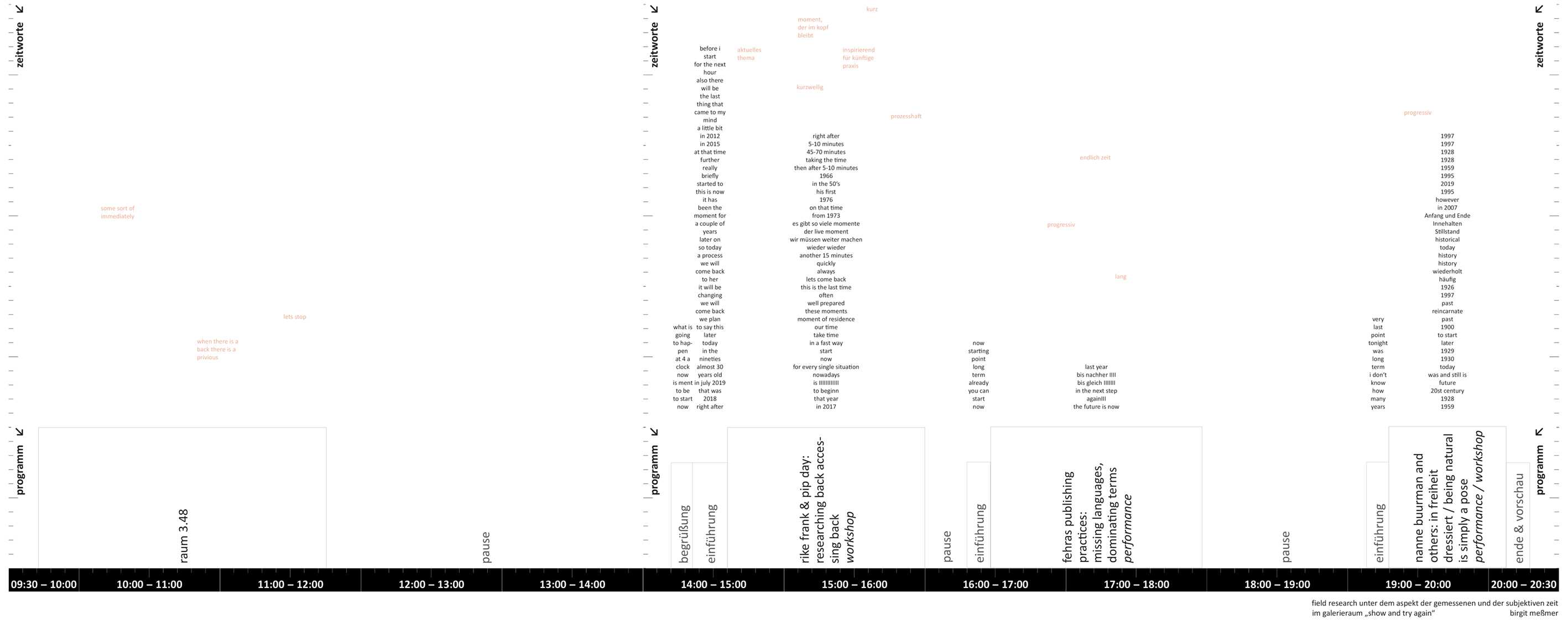
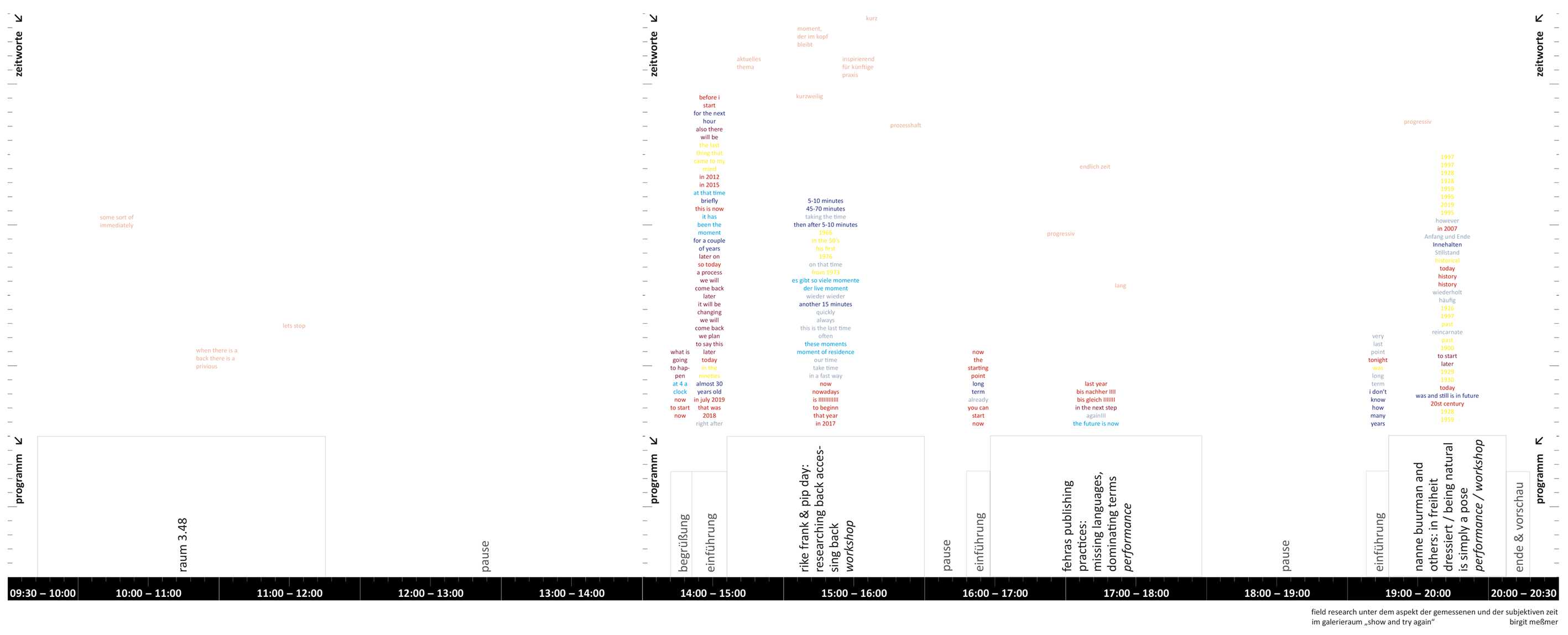
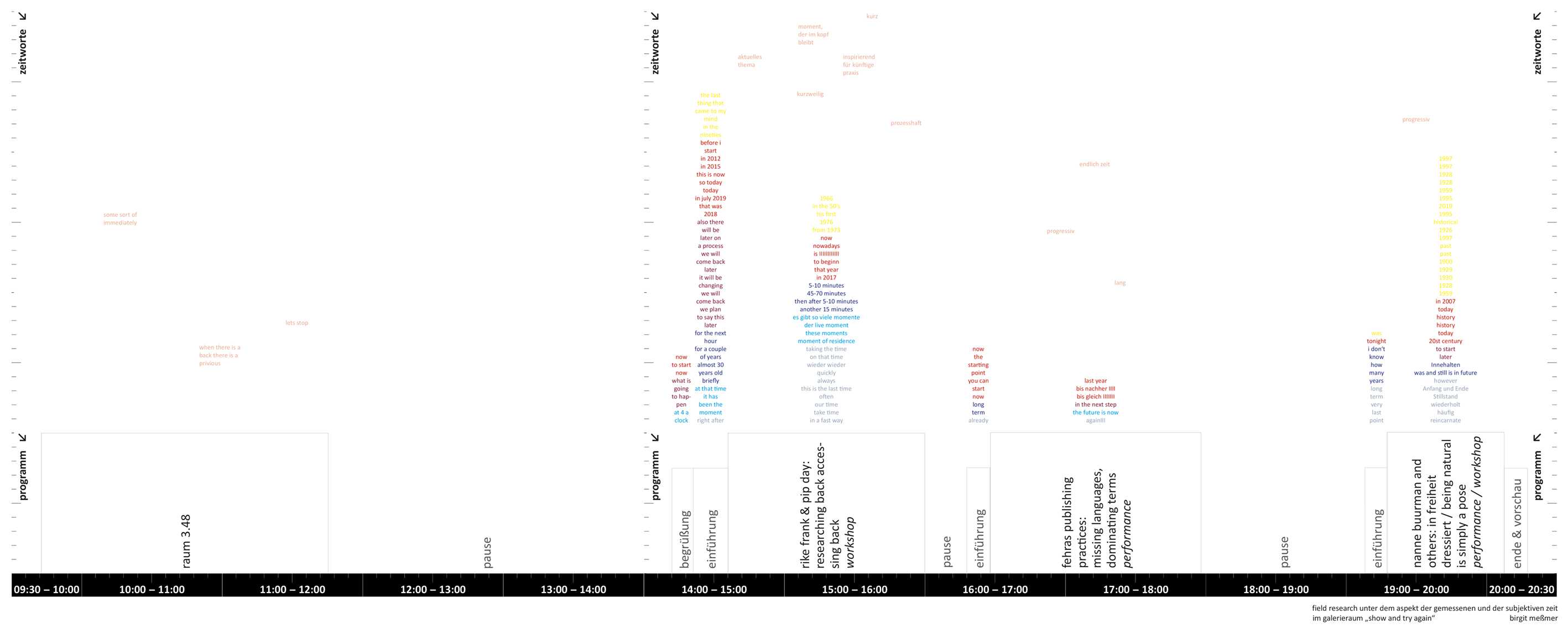
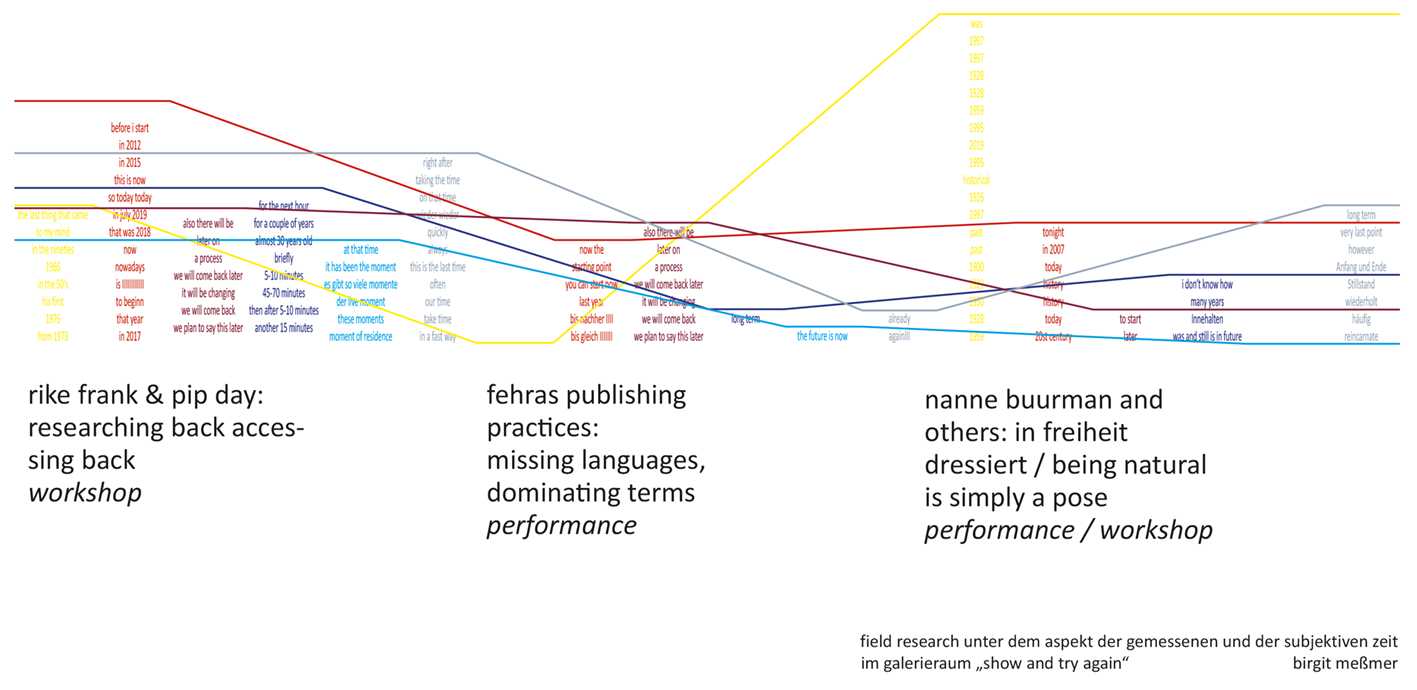
jonas von lenthe
Yes.
It was definitely an opener, it allowed for other people to speak, or at least to feel more comfortable to speak.
You were the first one from the audience to say something. Can you describe the situation and tell us what you said?
Sure. The topic of the discussion was about Q and A and conference exchange. They [Rike Frank and Pip Day] asked if anybody wanted to react to what was presented. No one reacted and they said ‘Is it not interesting?’ so I just answered ‘Yes’ and then I was given the mic because I was the only one who said even one word. Then I talked about how it was actually hard to speak in this context. I talked about intervention in a Q and A and how many people can feel shy to raise a question.
Did you have the feeling that they would give you a better surrounding to ask a question compared to other lectures?
I think at the beginning it was pretty conventional, in the way that they explained something and people had to react, which made it actually kind of hard to speak in that context. But then I would say during the talk we started thinking about group interactions, it felt easier to interact after a while throughout the conference.
Would you say that your interaction changed the protocol of what came then?
It was definitely an opener, it allowed for other people to speak, or at least feel more comfortable to speak, so yes.
